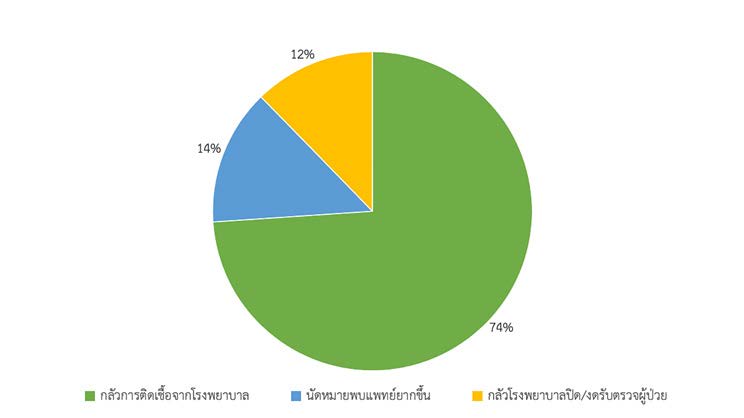Effect of COVID-19 Pandemic on Hospital Visits Among Patients with Dry Eye
Main Article Content
Abstract
Objective: To survey the concerns about the effect of COVID-19 pandemic on a hospital visit on the population's dry-eye symptoms, and the need for dry eye symptom treatment among Thailand's community-based population during the COVID-19 pandemic.
Materials & Methods: The online survey was distributed via various social media platforms about the effect of COVID-19 pandemic on hospital visits among people (dry eye and non-dry eye), the questionnaire available from June to July 2020 was open to everyone. In total, 535 people responded.
Results: During the COVID-19 pandemic, the concerns of the surveyed population were consistent with the need for healthcare services. The majority of respondents were concerned about infecting the COVID-19 virus from the hospital and spreading it to family members, especially patients with dry eye symptoms is concerned more than healthy people (p<0.05). As a result, most respondents denied going to the hospital or spent as little time as possible there because they were concerned about infecting the COVID-19 virus from the hospital.
Conclusion: Telemedicine development for patients with dry eye symptoms would provide a convenient and easily accessible platform for patients to receive recommendations on how to properly handle and manage dry eye symptoms during the COVID-19 pandemic. However, this necessitates constant service maintenance and development. As a result, healthcare services should be developed and modified to meet the needs of the patients.
Article Details

This work is licensed under a Creative Commons Attribution-NonCommercial-NoDerivatives 4.0 International License.
References
Gayton JL. Etiology, prevalence, and treatment of dry eye disease. Clin Ophthalmol. 2009;3:405-12.
Santen SA [Internet]. The impact of COVID-19 on people with dry eye disease: A survey initiated and funded by Santen SA. 2020. [cited 2022 Feb 14]. Available from: https://www.santen.eu/sites/files/default/2020-10/The impact of COVID-19 on people with DED report.pdf
Bahkir FA, Grandee SS. Impact of the COVID-19 lockdown on digital device-related ocular health. Indian J Ophthalmol. 2020;68(11):2378-2383.
Barabino S, Labetoulle M, Rolando M, Messmer EM. Understanding Symptoms and Quality of Life in Patients with Dry Eye Syndrome. Ocul Surf. 2016;14(3):365-76.
Prescott CR. Increased Screen Time and Dry Eye: Another Complication of COVID-19. Eye Contact Lens. 2021;47(8):433.
Neti N, Prabhasawat P, Chirapapaisan C, Ngowyutagon P. Provocation of dry eye disease symptoms during COVID-19 lockdown. Sci Rep. 2021;11(1):24434.
Patel S, Henderson R, Bradley L, Galloway B, Hunter L. Effect of visual display unit use on blink rate and tear stability. Optom Vis Sci. 1991;68(11):888-92.
Sweeney DF, Millar TJ, Raju SR. Tear film stability: a review. Exp Eye Res. 2013;117:28-38.
Wang MTM, Tien L, Han A, Lee JM, Kim D, Markoulli M, et al. Impact of blinking on ocular surface and tear film parameters. Ocul Surf. 2018;16(4):424-429.
Mehra D, Galor A. Digital Screen Use and Dry Eye: A Review. Asia Pac J Ophthalmol (Phila). 2020;9(6):491-497
Mineshita Y, Kim HK, Chijiki H, Nanba T, Shinto T, Furuhashi S, et al. Screen time duration and timing: effects on obesity, physical activity, dry eyes, and learning ability in elementary school children. BMC Public Health. 2021;21(1):422.
Argilés M, Cardona G, Pérez-Cabré E, Rodríguez M. Blink Rate and Incomplete Blinks in Six Different Controlled Hard-Copy and Electronic Reading Conditions. Invest Ophthalmol Vis Sci. 2015;56(11):6679-85.
Prabhasawat P, Pinitpuwadol W, Angsriprasert D, Chonpimai P, Saiman M. Tear film change and ocular symptoms after reading printed book and electronic book: a crossover study. Jpn J Ophthalmol. 2019;63(2):137-144.
ภิญนิตา ตันธุวนิตย์. โรคตาแห้ง. ใน : ภิญนิตา ตันธุวนิตย์, บรรณาธิการ. ตาแห้งและโรคผิวตา. พิมพ์ครั้งที่ 1. กรุงเทพฯ : สำนักพิมพ์ศิริราช, 2559 : 65-94.
เกวลิน เลขานนท์. คำจำกัดความ และการจัดหมวดหมู่ของโรคตาแห้ง. ใน : เกวลิน เลขานนท์, บรรณาธิการ. โรคตาแห้ง. พิมพ์ครั้งที่ 1. กรุงเทพฯ : โครงการตำตารามาธิบดี คณะแพทยศาสตร์โรงพยาบาลรามาธิบดี มหาวิทยาลัยมหิดล, 2561 : 1-21.
Lemp MA, Baudouin C, Baum J, Dogru M, Foulks GN, Kinoshita S, et al. The definition and classification of dry eye disease: report of the Definition and Classification Subcommittee of the International Dry Eye WorkShop (2007). Ocul Surf. 2007;5(2):75-92.
Craig JP, Nichols KK, Akpek EK, Caffery B, Dua HS, Joo CK, et al. TFOS DEWS II Definition and Classification Report. Ocul Surf. 2017;15(3):276-283.






